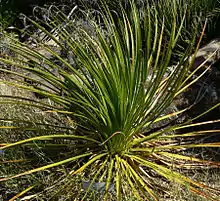Dasylirion leiophyllum
Dasylirion leiophyllum is a species of flowering plant in the asparagus family known by the common names green sotol, smooth-leaf sotol, and smooth sotol. It is native to North America, where it occurs in Chihuahua and Coahuila[2] in Mexico and New Mexico and western Texas in the United States.[3] It was first collected by Valery Havard in 1880 and was described by William Trelease in 1911.[4]
| Dasylirion leiophyllum | |
|---|---|
 | |
| Scientific classification | |
| Kingdom: | Plantae |
| Clade: | Tracheophytes |
| Clade: | Angiosperms |
| Clade: | Monocots |
| Order: | Asparagales |
| Family: | Asparagaceae |
| Subfamily: | Nolinoideae |
| Genus: | Dasylirion |
| Species: | D. leiophyllum |
| Binomial name | |
| Dasylirion leiophyllum | |
| Synonyms[1] | |
| |
This plant is a succulent shrub[3] with a trunk up to a meter long growing erect or reclining. The shiny, bright green, fibrous leaves are narrow, long, and pointed, growing up to 80 centimeters long by 2.5 wide. The margins have prickles. Mature specimens may wear a sheath of dead leaves from previous seasons around the trunk. The inflorescence is about 30 centimeters long[3] and is borne atop a stalk which can reach five meters in height.[2] The species is dioecious, with male and female reproductive structures on separate individuals. The many tiny flowers have whitish or greenish tepals about 2 millimeters in length. The fruit is a three-winged capsule under a centimeter in length. The plants reproduce by seed and vegetatively by sprouting from buds located at the leaf bases.[3]
This plant is native to the Chihuahuan Desert where it is dominant in a number of plant communities, often occurring with lechuguilla and walnut. It grows in woodlands and desert grasslands, often on calcareous substrates, and generally only in dry areas. Other plant species in the habitat may include prickly pear, yucca, nolina, Pinchot juniper, wavyleaf oak, skeleton goldeye, curlyleaf muhly, grama grasses, threeawns, and slim tridens.[3]
Mature individuals of this species can ignite and burn for hours if hit by lightning. Fire can then spread through the habitat if the burning top of the plant falls off and rolls down a hill. After the plant burns it can sometimes resprout from the buds at the leaf bases.[3]
This species of Dasylirion is one of several members of the genus to be used in the production of the Mexican spirit mezcal, despite it not being an Agave.
| Wikimedia Commons has media related to Dasylirion leiophyllum. |
References
- The Plant List
- Dasylirion leiophyllum. Flora of North America.
- Tesky, Julie L. 1993. Dasylirion leiophyllum. In: Fire Effects Information System, [Online]. U.S. Department of Agriculture, Forest Service, Rocky Mountain Research Station, Fire Sciences Laboratory.
- Morey, Roy (2008). Little Big Bend : Common, Uncommon, and Rare Plants of Big Bend National Park. Lubbock: Texas Tech University Press. p. 38. ISBN 9780896726130. OCLC 80359503.
